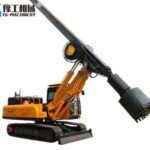Down-the-hole drilling machine is a type of drilling equipment that uses a percussion hammer located directly behind the drill bit. The hammer is powered by compressed air and delivers continuous impacts to the drill bit while the drill string rotates, allowing the machine to effectively penetrate hard rock formations. Down-the-hole drilling delivers impact energy directly to the drill bit, which reduces energy loss and provides better control and accuracy at greater depths.
Main Components of a Down-the-Hole Drilling Machine
1. Drill Rig
The drill rig is the central framework that supports the drilling operation. It includes the rotation unit, feed system, and control panel. The rig provides the necessary torque and thrust to drive the drill string into the ground.
2. Drill Pipe
The drill pipe connects the surface equipment to the hammer and bit. These pipes are typically made of high-strength steel and can vary in length depending on the depth and terrain being drilled.
3. Down the Hole Hammer
The hammer is the heart of the DTH system. It converts compressed air into a rapid succession of percussive impacts. The hammer is located directly behind the bit and provides the force needed to crush rock.
4. Drill Bit
DTH drill bits come in various sizes and shapes to suit different rock types and drilling objectives. They are usually made of tungsten carbide and designed to withstand extreme pressure and temperature.
How Does A Down The DTH Drilling Machine Work?
The operational principle of the down-the-hole drilling machine revolves around three core components: the drill bit, the DTH hammer, and the compressed air system.
- Compressed Air Generation: A high-pressure air compressor generates compressed air, which is channeled through the drill pipe to the DTH hammer.
- Hammer Activation: The compressed air activates a piston within the hammer, creating rapid reciprocating motion.
- Impact and Rotation: The piston strikes the drill bit, transferring kinetic energy to the rock. Simultaneously, the rotary head rotates the drill string, ensuring an even distribution of impact forces.
- Cuttings Removal: Compressed air exits through holes in the drill bit, flushing rock cuttings to the surface and maintaining a clean borehole.
This cyclical process allows the DTH machine to achieve penetration rates up to five times faster than conventional rotary drills in hard rock environments.
Wide Range of Applicable Scenarios
- Mining Operations
In open-pit and underground mining, Down-the-hole drilling machine create blast holes for explosives. Their ability to drill deep, vertical holes in hard rock ensures efficient fragmentation. - Water Well Drilling
DTH machines excel in drilling water wells, particularly in arid regions with hard bedrock. Their precision ensures minimal deviation, critical for accessing deep aquifers. - Geotechnical Investigations
Engineers use DTH drills to obtain soil and rock samples for analyzing subsurface conditions. The method provides accurate data for infrastructure projects like bridges, dams, and tunnels. - Construction and Piling
In urban construction, DTH rigs install foundation piles by drilling through concrete, boulders, and compacted soil. Their low vibration levels make them ideal for sensitive environments.


